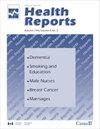加拿大家庭人口中的新冠肺炎感染。
IF 3.3
2区 医学
Q2 PUBLIC, ENVIRONMENTAL & OCCUPATIONAL HEALTH
引用次数: 6
摘要
某些人群面临着过度暴露于COVID-19的负担。这项研究调查了2020年秋季和2021年冬季居住在私人家庭中感染COVID-19的加拿大人的特征。数据和方法加拿大COVID-19抗体和健康调查旨在通过在线问卷和家庭手指刺血测试来估计加拿大私人家庭人群中COVID-19感染的血清阳性率。数据收集于2020年11月至2021年4月期间,来自10个省和三个地区首府的1岁或以上的受访者。使用描述性统计和逻辑回归来确定与过去COVID-19感染血清阳性相关的特征。研究了观察到的关联的性别差异。结果经协变量调整后,年龄较小和可见少数民族身份与过去COVID-19感染血清阳性的可能性增加相关。对于男性来说,具有明显的少数民族地位、受教育程度较低以及居住在多单元住宅中会增加血清阳性的可能性。如果女性在卫生保健部门工作并与他人直接接触,她们更有可能呈血清阳性。随着加拿大正在经历第五波,也可能是第六波大流行,了解谁更有可能在早期的浪潮中被感染,可以帮助正在进行的公共卫生努力阻止COVID-19的传播。本文章由计算机程序翻译,如有差异,请以英文原文为准。
COVID-19 infection in the Canadian household population.
Background
Certain population groups face a disproportionate burden of exposure to COVID-19. This study examined characteristics of Canadians living in private households in fall 2020 and winter 2021 who had been infected with COVID-19.
Data and Methods
With an online questionnaire and an at-home finger-prick blood test, the Canadian COVID-19 Antibody and Health Survey was designed to estimate the seroprevalence of COVID-19 infection among people in private households in Canada. Data were collected from respondents aged 1 or older in the 10 provinces and the three territorial capitals, from November 2020 to April 2021. Descriptive statistics and logistic regression were used to identify characteristics that were associated with being seropositive for a past COVID-19 infection. Gender differences in observed associations were examined.
Results
After covariate adjustment, younger age and visible minority status were associated with an increased likelihood of being seropositive for a past COVID-19 infection. For males, having a visible minority status, having less education and living in a multi-unit dwelling increased the likelihood of being seropositive. Females were more likely to have been seropositive if they worked in health care in direct contact with others.
Interpretation
As Canada navigates the fifth and possibly a sixth wave of the pandemic, understanding who was more likely to be infected in earlier waves can help ongoing public health efforts to stop the transmission of COVID-19.
求助全文
通过发布文献求助,成功后即可免费获取论文全文。
去求助
来源期刊

Health Reports
PUBLIC, ENVIRONMENTAL & OCCUPATIONAL HEALTH-
CiteScore
7.30
自引率
4.00%
发文量
28
期刊介绍:
Health Reports publishes original research on diverse topics related to understanding and improving the health of populations and the delivery of health care. We publish studies based on analyses of Canadian national/provincial representative surveys or Canadian national/provincial administrative databases, as well as results of international comparative health research. Health Reports encourages the sharing of methodological information among those engaged in the analysis of health surveys or administrative databases. Use of the most current data available is advised for all submissions.
 求助内容:
求助内容: 应助结果提醒方式:
应助结果提醒方式:


